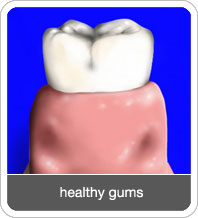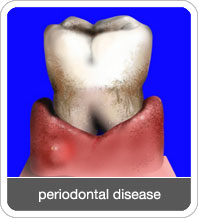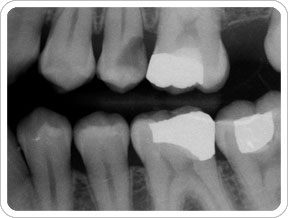Professional Cleanings
Professional cleanings (dental prophylaxis) performed by a certified dental hygienist form the foundation for preventing gum disease and tooth decay. In a professional cleaning, your hygienist will:
- Remove plaque from the teeth — Plaque is a sticky substance that forms in the mouth from food, saliva and bacteria. Plaque sticks to teeth and causes tooth decay and gum disease.
- Remove calculus (tarter) above the gum line — Calculus is plaque that has hardened on the tooth surface and is difficult to remove. (Calculus below the gum line indicates gum disease and requires a different procedure to remove it.)
- Polish and remove stains from teeth
Gum Disease
Gum disease (Periodontal Disease) is responsible for about 70 percent of adult tooth loss. It is characterized by swollen, inflamed gums surrounding the teeth. Plaque, a sticky substance that forms in the mouth from food, saliva and bacteria gets inside the space between the gum line and the tooth. If not removed, plaque hardens into a substance called calculus or tarter that is very difficult to remove. Eventually, the bacteria in the plaque and tarter eat away at the fibers that hold the gums to the teeth, creating deep pockets. As bacteria spread, the pockets become deeper until the bacteria finally eat away the bone that holds the tooth in place.
Gum disease is diagnosed through a process that measures the depth of the pockets around each tooth. Pockets that are greater than 3 millimeters in depth are considered hazardous and will generally require treatment.


How is gum disease treated?
Gum disease is treated by carefully removing the bacteria and substances that form in the pockets around the teeth. The removal of this material occurs on a microscopic level and requires great skill. Our dental team has had advanced training regarding how to effectively remove all of the bacteria.
This process of removing the bacteria usually requires several visits to our office. Once the bacteria have been removed, the pockets must be cleaned and maintained on a regular basis by a certified dental hygienist. Otherwise, the bacteria will return.
Dental Digital XRays
Digital radiography, “digital x-ray”, is the latest technology used to take dental x-rays. This technique uses an electronic sensor instead of the old x-ray film that captures and stores the digital image on a computer. This image can be instantly viewed and enlarged helping the dentist and hygienist detect problems easier and communicate those issues to you with our patient chair-side monitors. Digital x-rays reduce radiation 90% compared to traditional dental x-rays.
Dental x-rays are an essential, preventative, diagnostic tool that provide valuable information not visible during a regular dental exam. Dentists and dental hygienists use this information to safely and accurately detect hidden dental abnormalities and complete an accurate treatment plan. Without x-rays, problem areas may go undetected.


Dental x-rays may reveal:
- Abscesses or cysts.
- Bone loss.
- Cancerous and non-cancerous tumors.
- Decay between the teeth.
- Developmental abnormalities.
- Poor tooth and root positions.
- Problems inside a tooth or below the gum line.
Detecting and treating dental problems at an early stage may save you time, money, unnecessary discomfort, and your teeth!
Digital X-rays are Safe!
We are all exposed to natural radiation in our environment. Digital x-rays produce a significantly lower level of radiation compared to traditional dental x-rays. Not only are digital x-rays better for your health and safety, they are faster and more comfortable to take, which reduces your time in the dental office. Also, since the digital image is captured electronically, there is no need to develop the x-rays, thus eliminating the disposal of harmful waste and chemicals into the environment.
Even though digital x-rays produce a low level of radiation and are considered very safe, we still takes necessary precautions to limit your exposure to radiation. These precautions include only taking those x-rays that are necessary and using lead apron shields to protect the body.
When should dental x-rays be taken?
The need for dental x-rays depends on each patient’s individual dental health needs. We will recommend necessary x-rays based upon the review of your medical and dental history, a dental exam, signs and symptoms, your age, and risk of disease.
A full mouth series of dental x-rays is recommended for new patients. A full series is usually good for three to five years. Bite-wing x-rays of top and bottom teeth biting together are taken at recall (check-up) visits and are recommended once or twice a year to detect new dental problems.
Dental Exam
A comprehensive dental exam will be performed by Dr. Dave and his staff at your initial dental visit and at each subsequent visit. Regular exams are important to your dental as well as your overall health. Certain diseases may start or be seen first in the mouth. Dental exams are a part of early detection.
At regular check-up exams, your dentist and hygienist will include the following:
- Examination of diagnostic digital x-rays Essential for detection of decay, tumors, cysts, and bone loss. X-rays also help determine tooth and root positions.
- Oral cancer screening Check the face, neck, lips, tongue, throat, tissues, and gums for any signs of oral cancer.
- Gum disease evaluation Check the gums and bone around the teeth for any signs of periodontal disease.
- Examination of tooth decay All tooth surfaces will be checked for decay with special dental instruments.
- Examination of existing restorations Check current fillings, crowns, etc.